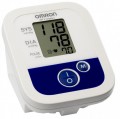Type
—
Mechanical. A classic design of a blood pressure monitor that many are familiar with includes a shoulder-worn cuff (see "Place of measurement"), a pear for cuff inflation, and a mechanical pressure indicator. This method of measurement requires a phonendoscope, which may be included with the blood pressure monitor or purchased separately. While the procedure is relatively simple, it demands a certain level of skill, and the accuracy of such measurements is considered the lowest among all types of blood pressure monitors. On the positive side, mechanical devices are straightforward in design, cost-effective, do not require a power supply, and can be used in any conditions.
—
Automatic. These blood pressure monitors are the most user-friendly: users simply need to place the cuff on the upper arm or wrist (see "Place of measurement") and press a button. The device autonomously handles cuff compression for measurements and displays the results on the screen. Automatic blood pressure monitors can come with various additional functions (see "Features") and are regarded as the most accurate. However, they necessitate mains or battery power and are more expensive compared to other types.
—
Semi-automatic. These blood pressure monitors serve as a "transitional option" between mechanical and automatic devices. They employ electronic sensors for measurements similar
...to automatic ones, but the cuff is manually inflated using a pear. This design enables the inclusion of additional functions typically found in automatic blood pressure monitors at a considerably lower cost. However, they do require a power supply (although they are more energy-efficient than automatic ones due to the absence of a compressor), and their measurement accuracy is lower compared to automatic models.Battery indicator
Here, it refers to a
battery level indicator on the blood pressure monitor display, showed as an icon similar to those found on mobile phones. While the charge indication is typically approximate, this feature allows users to monitor battery status and prepare for replacements in advance.
Pressure measuring range
The effective measurement range of a blood pressure monitor covers both "upper" and "lower" pressure values. Most modern devices have a lower limit within 0-20 mm Hg, which is adequate for the majority of cases. As for the upper limit, a device with a maximum value of 180 mm Hg is generally sufficient for individuals without a history of significant blood pressure spikes until old age or without serious illnesses. However, for those prone to substantial increases, it's advisable to consider devices with higher upper limit values, which can reach up to 280 mm Hg in modern blood pressure monitors.
Pulse measurement range
The blood pressure monitor's pulse rate measurement capability typically falls within a range of 30-40 to 180 beats per minute. While extending the lower limit is unnecessary for household blood pressure monitors, a higher upper limit may be essential for measurements during intense physical activity or for individuals with conditions causing significant heart rate acceleration, such as tachycardia.
Cuff dimensions
The cuff's applicable range includes both the minimum and
maximum circumferences of the upper arm or wrist (see "Place of measurement"). Modern blood pressure monitors typically feature cuffs suitable for individuals with average physique, covering the majority of adult patients. However, for specialized cases, such as monitoring a child or someone with a larger bicep circumference, it is advisable to measure the arm circumference and compare it with the specified cuff sizes.
—
Small. The small cuffs are designed for a shoulder girth of 17-22 cm.
—
Standard. Standard cuffs cover a shoulder girth of 22-32 cm.
—
Oversized. Oversized cuffs have a girth of 22-36 cm.
—
Universal. Cuffs for both thin and large people. Universal cuffs provide a shoulder girth of 22-42 cm.
—
Large. Large cuffs with a girth of 33-46 cm are suitable for a full arm or a muscular shoulder of a conditional bodybuilder.
Recording readings
The number of results that can be simultaneously stored in the blood pressure monitor's memory. The ability
to store several results in memory can be useful, for example, to compare pressure readings in the morning, afternoon and evening — these results do not have to be manually recorded or memorized.
In box
—
Additional cuff. The blood pressure monitor set includes two cuffs, main and auxiliary, which differ from each other only in standard size. Usually, the auxiliary cuff has a longer length. For example, if the length of the main cuff is 22-36 cm, then the auxiliary cuff will be one size larger, that is, 30-42 cm. An additional larger cuff allows you to expand the circle of users of the blood pressure monitor.
—
Power source. Blood pressure monitors with a power supply option can operate using a 230 V household power supply, eliminating the need for frequent battery replacements. Interestingly, many of these monitors also come equipped with batteries, providing users flexibility in choosing the power source for the measuring device.
—
Cover/case. The blood pressure monitor comes with a dedicated bag for convenient storage and transportation of all its components. Depending on the tonometer's configuration, the case can accommodate the device, primary and auxiliary cuffs, a stethoscope, spare batteries, a power supply, and instructions. Some cases even include an extra compartment for storing medications. Typically, the tonometer bag is soft.
— Batteries. The blood pressure monitor operates on replaceable batteries, commonly using AA or AAA batteries. This battery-powered design makes the device self-contained, allowing its use in remo
...te locations or while traveling without access to a household electrical outlet. However, a drawback of battery-powered blood pressure monitors is the requirement for regular battery replacement or recharging.
